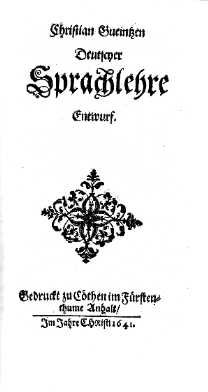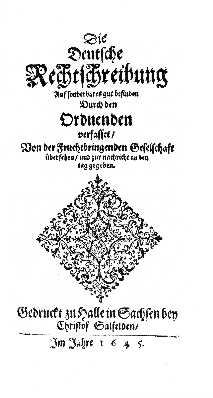The German grammarian Christian Gueintz |
Updated: 02/17/2010 |
||||||||||
General perceptionDespite of his importance within the "Fruchtbringenden Gesellschaft", the most famous German language society, today Christian Gueintz is a nearly forgotten grammarian. [3] So Christian Gueintz's merits in German language were given less appreciation in the general compendiums of German language history. [2] Adolf Bach (1979) indicates his both works, "Deutsche Sprachlehre (Entwurf)" and "Deutsche Rechtschreibung" besides of the scriptures of Luther and the "Reichstagsabschiede" as decisive for the German language, whereas in this single reference to him pointed out more the merits of Luther than those of Gueintz. At Heinz Eggers (1969) is mentioned that Gueintz wrote the "Deutsche Sprachlehre" only as a member of the "Fruchtbringenden Gesellschaft" und continued: "The various more or less successful attempts in the following time we can pass here inclusive the insufficient 'Sprachlehre' of the above mentioned Christian Gueintz ... ". For him was the first German grammarian Justus Georg Schottel. [2] John Watermann (1991) looks on it a little bit more differentiating and judge Gueintz's work "Die Deutsche Sprachlehre" as a high remarkably work. It is affected by a pedantic and the reader bothering attempt to put the parts of a language in a logical classification. It leads to an unpredictable but indirect significant step: it leads to the well know grammar of 17th century of Justus Georg Schottel who tries to compensate, which was weak in the work of Gueintz. [2] |
On this page: Background of missing Acceptance |
||||||||||
Background of missing acceptanceWithin the Fruchtbringenden Gesellschaft bounced at that time in the linguistically question of orientation in cases of doubt two direction against each other: the anormalists and the analogists. The conservative anormalists allow the accepted use of language a normative impact. "In doubt write as you speak." Princely Ludwig of Anhalt-Koethen the head of the Fruchtbringenden Gesellschaft and Christian Gueintz, who Ludwig knew from the reforms of Ratke in Koethen, took this position. [3] Meanwhile the younger analogists advanced the view that the
language has to follow the mandatory ideal rules for the grammar.
To this direction belong Georg Philipp Harsdroeffer and Justus
Georg Schottelius. [3] For Markus Hund (2000) is the important point in the fact that the analogists belong to the younger generation and therefore their viewpoint survived. But even Schottelius has to accept also sociolinguistic points besides the pure analogy as standard giving fact. [3] Within the numerous treatises there are direct comparisons between the works of Gueintz and Schottelius seldom, and unfortunately there is still no monograph written about Gueintz. [3] |
 |
||||||||||
His both grammatical worksDeutsche Sprachlehre (Entwurf) 1641
The "Sprachlehre" consists of different introduction pages and dedications to Princely of Braunschweig and Luneburg and Princely Ludwig of Anhalt, Lord of Askanien, Lord of Bremburg and Zerbst; a statement on the value of German language, as well as seven pages to the reader with the reason why there is a need of grammar. [2]
A manuscript of this work published in1641 in Koethen for the first time circulates since November 1638 for reason of revision among the members of the "Fruchtbringenden Gesellschaft", amongst others No. 2 (Ludwig Princely of Anhalt-Koethen), No. 31 (Diederich von dem Werder), Nr. 200 (Martin Opitz), Nr. 227 (August the younger Duke of Braunschweig and Luneburg-Wolfenbuttel) and other scholars, as Buchner and Schottelius, who later become affiliated to the "Fruchtbringende Gesellschaft" under No. 362 and No. 397, as well as among the old collaborators at the reforms of Ratke in Koethen, as Balthasar Walter and Martini. Therefore one can say that this grammar is the first attempt to develop grammatical rules terminological on base of Ratke. [1] Already one century later Reichards (1747) judges, that the attempt to align German language is not well done. [5] Jelinek (1913) lists several deficiencies in the "Sprachlehre". For example the permanent mistake, to define tenses, different tenses for the same thoughts, same tenses for different thoughts, the lack of illustrating examples and the irritating layout of presentation, the until distraction driven dichotomies (bifurcation, furcation). [2] For Takada (1981) the "Deutsche Sprachlehre" was designed as school grammar because of its compactness. It follows extensively the "Allgemeinen Sprachlehre" and the "Allunterweisung" of Ratke. The shortness of presentation, the lack of any justifications and examples avoids easy traceability for the reader. For Hundt (2000) lead two essential criteria to the incomprehensibleness of the work: the text is too less explicit (too less detailed presented) and the lack of any explanation. [3] |
As reprint: Georg Olms Verlag, Documenta Linguistica, Hildesheim, New York (1978) |
||||||||||
Deutsche Rechtschreibung 1645
Herein the orientation to the etymology (origin) of the word, its pronunciation and the practice is specified. However, unclear remains, when which principle should be valid. Gueintz was geared in individual cases to Luther's bible translation: "Schwer mit dem langem e einsylbig/ das grosse last hat. Psal. 32/ 4. Den deine hand war tag und nach schwer auf mir." [3] The "Deutsche Rechtschreibung" consists predominantly of a table of words. Opposite of the "Deutschen Sprachlehre" was the "Deutsche Rechtschreibung" published four times, which indicates a higher acceptance. Obviously were the lists of words quiet implementable for looking-up words. Harsdoerffer remarks that the "Deutsche Rechtschreibung" was used in the diplomatic negotiations in the ambit of the Peace of Westphalia. [3] Reichards (1747) described 100 years after the appearance of the first edition: "The rules and annotations or trade as the author specifies, are mostly established and even today still valid." [5] |
As reprint: Georg Olms Verlag, Documenta Linguistica, Hildesheim, New York (2008) |
||||||||||
ConclusionBesides this, mostly from the point of knowledge today, thus from the retrospective deduced judgment, the contemporary reference must not disregarded. After one and a half century oppression of science by the Christian church humanity was about rediscovering the findings of the antiquity in the renaissance and humanism. Thereby one have had difficulties to emancipate oneself from the primacy of theology and to detach oneself from the bondage of the text of the bible. Thus it is explicable that Gueintz come from the point that the German language raises out the Babylonian language confusion (Deutsche Sprachlehre, page 2).
|
About scholastism an humanism
|
||||||||||
Sources
|
|
 The
main section is split. The first book contains 21 chapters: grammar,
spelling, pronunciation, the differences and the word analysis
- the etymology. The other book contains 16 chapters: the joining
of words, differentiation, which means punctuation, as well as
syntax. At the end are following several pages of Latin made-up
words with its German equivalents. [2]
The
main section is split. The first book contains 21 chapters: grammar,
spelling, pronunciation, the differences and the word analysis
- the etymology. The other book contains 16 chapters: the joining
of words, differentiation, which means punctuation, as well as
syntax. At the end are following several pages of Latin made-up
words with its German equivalents. [2] The
"Deutsche Rechtschreibung is a typical example of the work
within the "Fruchtbringenden Gesellschaft". Gueintz
has finished the manuscript in1643. Two years the work circulates
among the members of the "Fruchtbringenden Gesellschaft",
it was cross-read, there were opinions furnished and single points
discussed in written form, before it could get printed. Therefore
the "Deutsche Rechtschreibung" can be considered as
a collective product of the members of the "Fruchtbringenden
Gesellschaft". [3]
The
"Deutsche Rechtschreibung is a typical example of the work
within the "Fruchtbringenden Gesellschaft". Gueintz
has finished the manuscript in1643. Two years the work circulates
among the members of the "Fruchtbringenden Gesellschaft",
it was cross-read, there were opinions furnished and single points
discussed in written form, before it could get printed. Therefore
the "Deutsche Rechtschreibung" can be considered as
a collective product of the members of the "Fruchtbringenden
Gesellschaft". [3]